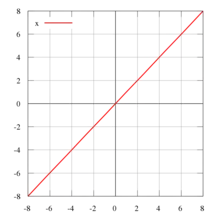Identity function
In mathematics, an identity function, also called an identity relation or identity map or identity transformation, is a function that always returns the same value that was used as its argument. That is, for f being identity, the equality f(x) = x holds for all x.

Definition
Formally, if M is a set, the identity function f on M is defined to be that function with domain and codomain M which satisfies
- f(x) = x for all elements x in M.[1]
In other words, the function value f(x) in M (that is, the codomain) is always the same input element x of M (now considered as the domain). The identity function on M is clearly an injective function as well as a surjective function, so it is also bijective.[2]
The identity function f on M is often denoted by idM.
In set theory, where a function is defined as a particular kind of binary relation, the identity function is given by the identity relation, or diagonal of M.[3]
Algebraic properties
If f : M → N is any function, then we have f ∘ idM = f = idN ∘ f (where "∘" denotes function composition). In particular, idM is the identity element of the monoid of all functions from M to M.
Since the identity element of a monoid is unique,[4] one can alternately define the identity function on M to be this identity element. Such a definition generalizes to the concept of an identity morphism in category theory, where the endomorphisms of M need not be functions.
Properties
- The identity function is a linear operator, when applied to vector spaces.[5]
- The identity function on the positive integers is a completely multiplicative function (essentially multiplication by 1), considered in number theory.[6]
- In an n-dimensional vector space the identity function is represented by the identity matrix In, regardless of the basis.[7]
- In a metric space the identity is trivially an isometry. An object without any symmetry has as symmetry group the trivial group only containing this isometry (symmetry type C1).[8]
- In a topological space, the identity function is always continuous.[9]
- The identity function is idempotent.[10]
See also
References
- Knapp, Anthony W. (2006), Basic algebra, Springer, ISBN 978-0-8176-3248-9
- Mapa, Sadhan Kumar (7 April 2014). Higher Algebra Abstract and Linear (11th ed.). Sarat Book House. p. 36. ISBN 978-93-80663-24-1.
- Proceedings of Symposia in Pure Mathematics. American Mathematical Society. 1974. p. 92. ISBN 978-0-8218-1425-3.
...then the diagonal set determined by M is the identity relation...
- Rosales, J. C.; García-Sánchez, P. A. (1999). Finitely Generated Commutative Monoids. Nova Publishers. p. 1. ISBN 978-1-56072-670-8.
The element 0 is usually referred to as the identity element and if it exists, it is unique
- Anton, Howard (2005), Elementary Linear Algebra (Applications Version) (9th ed.), Wiley International
- D. Marshall; E. Odell; M. Starbird (2007). Number Theory through Inquiry. Mathematical Association of America Textbooks. Mathematical Assn of Amer. ISBN 978-0883857519.
- T. S. Shores (2007). Applied Linear Algebra and Matrix Analysis. Undergraduate Texts in Mathematics. Springer. ISBN 978-038-733-195-9.
- James W. Anderson, Hyperbolic Geometry, Springer 2005, ISBN 1-85233-934-9
- Conover, Robert A. (2014-05-21). A First Course in Topology: An Introduction to Mathematical Thinking. Courier Corporation. p. 65. ISBN 978-0-486-78001-6.
- Conferences, University of Michigan Engineering Summer (1968). Foundations of Information Systems Engineering.
we see that an identity element of a semigroup is idempotent.
